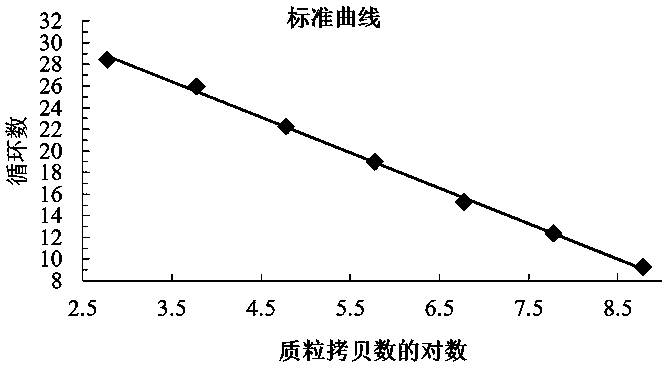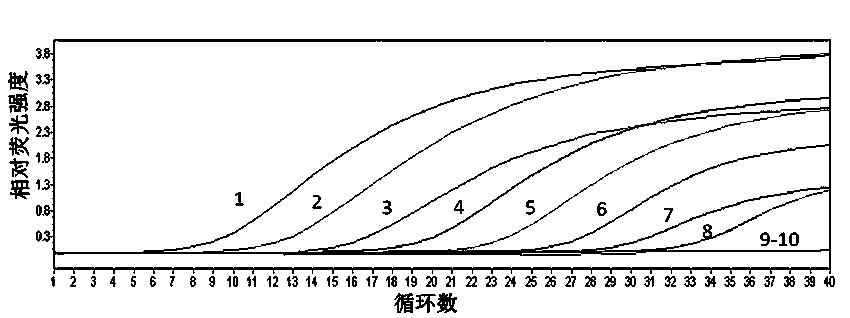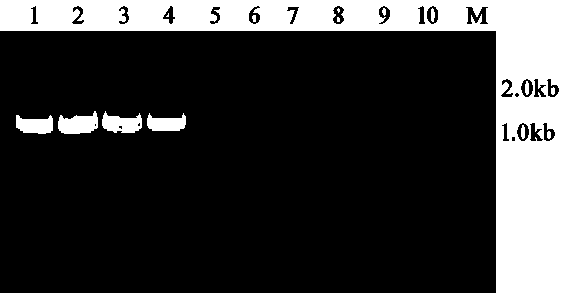Qualitative and quantitative detection method for Xinjiang isolates of apricot chlorotic leaf roll (ACLR) phytoplasma
A quantitative detection method and quantitative detection technology, which are applied in the determination/inspection of microorganisms, biochemical equipment and methods, DNA/RNA fragments, etc. The qualitative and quantitative detection of Xinjiang isolates has achieved the effect of high sensitivity, improved sensitivity and strong specificity
- Summary
- Abstract
- Description
- Claims
- Application Information
AI Technical Summary
Problems solved by technology
Method used
Image
Examples
Embodiment 1
[0040] The preparation of embodiment 1 primer and probe
[0041] 1. Design and synthesis of primers and probes
[0042] The primers and probes used for the real-time fluorescence quantitative PCR detection of the phytoplasma chlorophyllum phytoplasma Xinjiang isolates of apricot chlorosis are designed and synthesized as follows: at first, the 16S rDNA nucleic acid sequences of all phytoplasma and representative bacteria are collected in NCBI, and the Omiga software compared the above sequences and analyzed the consistency to find out the genetic difference sites between the Xinjiang isolate of Phytoplasma chlorophyllum and other phytoplasma, and a pair of primers were screened out with the software Beacon Designer 7.0, and in the primer pair A fluorescent Taqman probe is set in the amplification region, the reporter fluorescent dye is labeled at the 5' end of the probe, and the quencher fluorescent dye is labeled at the 3' end of the probe. After the design of PCR primers and...
Embodiment 2
[0047] Example 2 Establishment of real-time fluorescent PCR detection method for apricot chlorotic phytoplasma Xinjiang isolate
[0048] 1. Extraction of total plant DNA: Plant Genomic DNA Kit (TIANGEN) was used to extract total DNA from phloem or leaf veins of apricot branches, and stored in a -40°C refrigerator for later use.
[0049] 2. PCR Amplification of 16S rDNA from Xinjiang Isolate of Phytoplasma Chlorophyta Curls from Apricot
[0050] The 16S rDNA gene fragment of Phytoplasma chlorophyll rolls was amplified with the universal primer pair R16mF2: 5'-CATGCAAGTCGAACGGA-3', R16mR2: 5'-CTTAACCCCAATCATCGA-3'. PCR reaction system (25µL): 2.0µL DNA template, 1.0µL each primer (10µmol / L), 1.0µL dNTP (10mmol / L), 10×PCR Buffer (2.5mmol / L MgCl 2 ) 2.5 µL, Taq DNA polymerase (2.5U / µL) 0.3µL, supplemented with ddH 2 0 to 25.0 µL. Reaction conditions: pre-denaturation at 94°C for 4min; denaturation at 94°C for 45s, renaturation at 50°C for 45s, extension at 72°C for 1min, 35 cy...
Embodiment 3
[0067] Example 3 Application of real-time fluorescent PCR detection method for apricot chlorotic leaf roll Phytoplasma Xinjiang isolate
PUM
 Login to View More
Login to View More Abstract
Description
Claims
Application Information
 Login to View More
Login to View More - R&D
- Intellectual Property
- Life Sciences
- Materials
- Tech Scout
- Unparalleled Data Quality
- Higher Quality Content
- 60% Fewer Hallucinations
Browse by: Latest US Patents, China's latest patents, Technical Efficacy Thesaurus, Application Domain, Technology Topic, Popular Technical Reports.
© 2025 PatSnap. All rights reserved.Legal|Privacy policy|Modern Slavery Act Transparency Statement|Sitemap|About US| Contact US: help@patsnap.com



